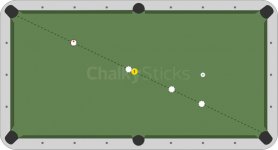Maybe I'm not understanding the point of this thread. If a player has a poor stroke (possibly due to an unstable bridge hand or improper grip hand), they could have excellent visual aiming skills but lack the basic fundamentals needed to consistently get their cue in line for the shot. Is it the visual skill of aiming that you are asking about as far as testing? If a player has a good stroke, and good body alignment, they will immediately know whether or not their visual aim is accurate when they shoot a shot and miss it. If a player has a bad stroke they really won't know if they're missing balls due to their bad stroke, poor alignment, or faulty visual aim.
A good stroke is only part of the aiming process. Then there's alignment, positioning your body in a way that allows the stroke to lock onto a specific visual aim line or distant target point. These two parts act as one machine. And we have visualization, what your eyes are feeding the brain. The brain then directs the machine to perform the task, preferably through subconscious thought. All of these parts are needed in order to aim with accuracy and consistency.
I like what One Pocket John said about front and rear aiming sights. That's a great way to look at it, get the two sights tracking together toward a designated target. As long as your body is aligned properly, and your stroke is sighted properly, you should immediately know if you're aiming accurately as soon as you strike the CB.
Is this "test" for aiming supposed to pinpoint a flaw in any specific part of the aiming process? Or does the test only pertain to the visual aspect? That would be a great test...a test that would definitively show where any fault occurs.
As you mentioned in line 2, if a player has poor stroke, he could have excellent visual aim. That is the point. Keyword is "could". How could he checked that? He has no way to check that because he has poor stroke. If his aiming is poor, then even if he improves his stroke dramatically, he will still have low self confidence due to inconsistency in making balls.
One pocket John's view of rear sight aperture is noted. To me, this is still not true aiming since you do not use your eye behind to align the two points.
This thread is to find out whether you think there is a need to do this test. I am an average player hence I would do this test if I could. Gives me a world of confidence to know that I am pointing correctly especially for long straight in shots. A small deviation and I miss, and I do not know if it is my aiming or other factors that causes the miss. Most of us attribute it to our cuing action or the beer we drink.
Last edited:
